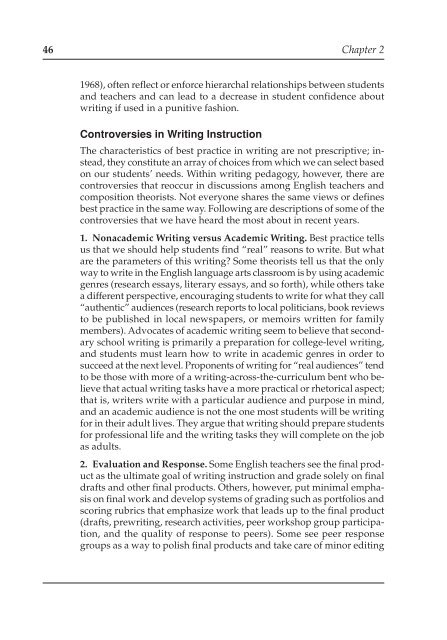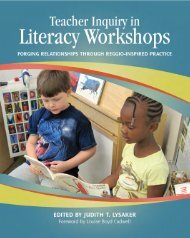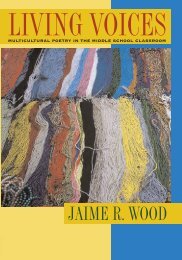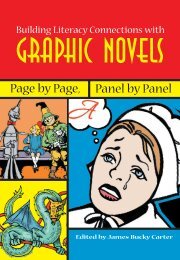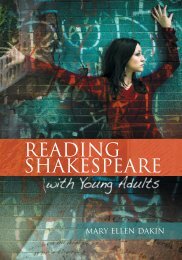2 Narratives about Teaching Writing - National Council of Teachers ...
2 Narratives about Teaching Writing - National Council of Teachers ...
2 Narratives about Teaching Writing - National Council of Teachers ...
- No tags were found...
Create successful ePaper yourself
Turn your PDF publications into a flip-book with our unique Google optimized e-Paper software.
46 Chapter 21968), <strong>of</strong>ten reflect or enforce hierarchal relationships between studentsand teachers and can lead to a decrease in student confidence <strong>about</strong>writing if used in a punitive fashion.Controversies in <strong>Writing</strong> InstructionThe characteristics <strong>of</strong> best practice in writing are not prescriptive; instead,they constitute an array <strong>of</strong> choices from which we can select basedon our students’ needs. Within writing pedagogy, however, there arecontroversies that reoccur in discussions among English teachers andcomposition theorists. Not everyone shares the same views or definesbest practice in the same way. Following are descriptions <strong>of</strong> some <strong>of</strong> thecontroversies that we have heard the most <strong>about</strong> in recent years.1. Nonacademic <strong>Writing</strong> versus Academic <strong>Writing</strong>. Best practice tellsus that we should help students find “real” reasons to write. But whatare the parameters <strong>of</strong> this writing? Some theorists tell us that the onlyway to write in the English language arts classroom is by using academicgenres (research essays, literary essays, and so forth), while others takea different perspective, encouraging students to write for what they call“authentic” audiences (research reports to local politicians, book reviewsto be published in local newspapers, or memoirs written for familymembers). Advocates <strong>of</strong> academic writing seem to believe that secondaryschool writing is primarily a preparation for college-level writing,and students must learn how to write in academic genres in order tosucceed at the next level. Proponents <strong>of</strong> writing for “real audiences” tendto be those with more <strong>of</strong> a writing-across-the-curriculum bent who believethat actual writing tasks have a more practical or rhetorical aspect;that is, writers write with a particular audience and purpose in mind,and an academic audience is not the one most students will be writingfor in their adult lives. They argue that writing should prepare studentsfor pr<strong>of</strong>essional life and the writing tasks they will complete on the jobas adults.2. Evaluation and Response. Some English teachers see the final productas the ultimate goal <strong>of</strong> writing instruction and grade solely on finaldrafts and other final products. Others, however, put minimal emphasison final work and develop systems <strong>of</strong> grading such as portfolios andscoring rubrics that emphasize work that leads up to the final product(drafts, prewriting, research activities, peer workshop group participation,and the quality <strong>of</strong> response to peers). Some see peer responsegroups as a way to polish final products and take care <strong>of</strong> minor editing


